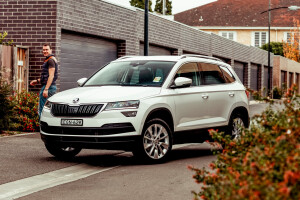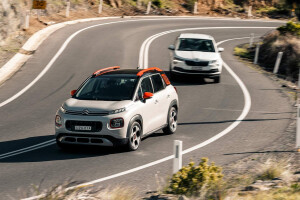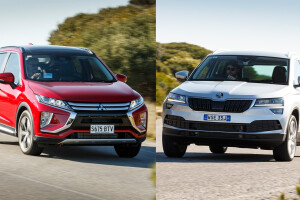Latest Review
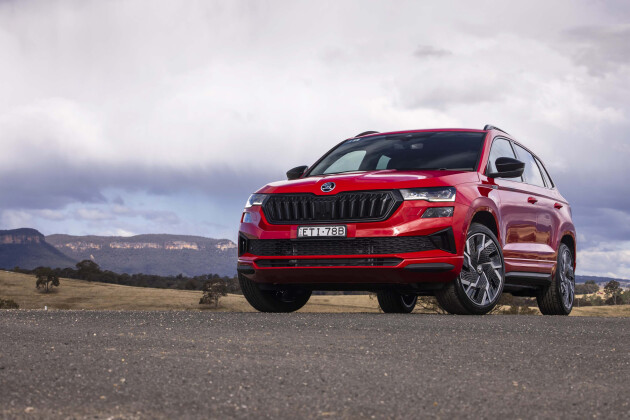
VIDEO: 2023 Skoda Karoq review – Australian first drive
Look past the updated Skoda Karoq’s pricetag and you’ll find a lot of car for the cash
UPDATE: 2023 Skoda Karoq video review
We've added a fresh new 2023 Skoda Karoq video review to this story, so dive in and enjoy.
Will you be looking at a Karoq for your next car? Tell us in the comments below. And if not, what are you looking at instead?
In 2018, Skoda finally filled the mid-sized-SUV-shaped gap in its growing local line-up with the Karoq. With a choice of just one engine and even the option of a manual transmission, it initially appeared as though Skoda was merely testing the water. But in 2020 the company got serious about the segment by introducing an updated version of the initial 110TSI, dropping the manual and topping off the range with a new 140TSI Sportline.
When we drove the refreshed and bolstered line-up, the Karoq made a good impression with generous standard equipment, lively driving dynamics and plenty of Skoda’s ‘simply clever’ features. And yet, two years on, with less than a two per cent share of the sub-$60,000 medium SUV market, the Karoq is still struggling to gain the attention that many (myself included) believe it deserves.
At the time, some argued that a model priced from $29,990 in a heavily price-led segment was too expensive. If that remains true today, the Karoq is in trouble because this latest update starts at $42,990 drive-away.
But wait. It would be too easy to ignore this compelling car purely on the grounds of cost before taking the time to look into exactly what it’s offering for the cash. In short, there’s a lot.
With the latest mid-life refresh, the entry-level Style now costs $42,990 drive-away, while the Sportline has risen to $49,990 drive-away, which makes the Karoq more expensive than equivalent variants of Honda’s CR-V, the Mazda CX-5 and Toyota RAV4 for example.
It doesn’t take long behind the wheel of the Karoq, however, to realise a genuine equivalent doesn’t really exist in any of the established Japanese players’ ranges.
The Skoda takes its underpinnings from the Volkswagen Group’s MQB platform which closely relates the Karoq to premium offerings such as the Audi Q3, Volkswagen Tiguan and Cupra Formentor, and it shows.
It doesn’t take long behind the wheel of the Karoq to realise a genuine equivalent doesn’t really exist among the Japanese brands.
Even at the entry point, Skoda has laden the Karoq with gear including a fully digital instrument cluster known across VW Group brands as the Virtual Cockpit. Keyless entry and engine start is standard, as is a power tailgate with hands-free opening, ventilated glovebox, cool Skoda-branded welcome lights and dual-zone climate control.
Technology is equally well catered for with Android Auto and Apple CarPlay offered in both versions. You’ll have to step up to the Sportline to provide a wireless connection to these smartphone mirroring systems, but at least in the Style there are contemporary USB-C connectors.
And while others in the game have touchscreens to rival the 8.0-inch standard offering, few can match its sharp resolution and fast, intuitive operation.
Driver assistance and safety features complete the compelling list of kit included in the price, with parking sensors all round complemented by a sharp, wide-angle reversing camera, autonomous emergency braking, automatic braking during parking and adaptive cruise control.
The latter is one of the most natural in operation but it’s calibrated to follow cars in faster lanes and prevent undertaking, which wouldn’t be a problem in Europe where freeway drivers generally keep to the slower lanes unless overtaking. In Australia however…
Even in off-the-shelf trim, the entry-level Karoq feels premium. From its beautifully contoured leather steering wheel to the upholstery fabric that feels almost as special as leather (and certainly more interesting), it has pleasant interior materials throughout and a roomy feel.
Regardless of variant, the lack of seat tilt adjustment detracts from an otherwise excellent seating position, while the most impressive 9.2-inch central screen with navigation and clever gesture control is only available as an option.
From an equipment perspective, not a huge amount changes when stepping up to the flagship Sportline as most of the upgrades are limited to aesthetic touches. It rolls on larger 19-inch alloy wheels, the headlights gain adaptive LED matrix technology and black exterior highlights continue inside the cabin, which also features sports seats.
A majority of its price premium comes down to a larger engine, sportier transmission and all-wheel drive, but more about that later.
In both cases, the Karoq’s value for money is stacking up well but some excellent practical features keep adding to the virtues.
With an extra differential to accommodate under the boot floor, the Sportline has the smallest luggage capacity but can still swallow up to 521 litres of things, expanding to 1630L with the second row of seating folded.
The Style, however, is the load champ with an excellent 588-litre boot, but its Varioflex rear seats are the secret space weapon. This feature allows the second row to fold and tumble toward the front seats but if this still doesn’t liberate enough volume, the entire row can be quickly and simply unlatched and completely removed from the car in three pieces. This clever trick expands the useable load space to a whopping 1810 litres.
On the Style’s exterior, the 2022 Karoq update has brought a noticeable design refresh incorporating LED headlights at the front and dynamic LED indicators at the tail end. 17-inch alloy wheels have grown to 18 inches and are now presented in a cool Miran design with a black finish.
While the previous version could look a little rental-fleet spec, especially in white, the updated Karoq has a far greater premium feel and presence.
It’s worth pointing out that in Europe, the Karoq is available in two variants beneath the Style version we’re offered as the most affordable option in Australia, which explains both the respectable levels of equipment and the corresponding pricing. Think not of the Style as a pricey base version, but as a reasonably positioned mid-range option.
Those who want a version of the Karoq that really is expensive, however, need only get a little too enthusiastic with the optional packages.
Upgrading the Style to a bigger touchscreen, matrix LED headlights, extra driver assistance features and ambient lighting costs $5900, although Skoda points out that the Tech Pack kit would cost $8330 if all its goodies were optioned up separately.
Think not of the Style as a pricey base version, but as a reasonably positioned mid-range option.
The Premium Pack brings leather seats with electric adjustment and memory for the front row, heaters for the four main seats as well as the steering wheel – which gains paddleshifters – for a hefty $10,900, but that’s still 24 per cent cheaper than individually picking each item, says Skoda.
Given the Sportline's higher overall level of specification, the option packs cost less to apply. This means upgrading to the big screen with sat-nav, seat and steering wheel heating, adaptive damping and a few other goodies adds $5900 to the bottom line, while leather upholstery and electric front seat adjustment are bundled at $3200.
Here’s a top tip: If you intend to get stuck into the options packs then it certainly makes more sense to start with the Sportline as your not-particularly-blank canvas.
With both packs optioned onto each variant, the Style actually works out $700 more expensive, so you could say the Sportline’s more powerful driveline, sporty looks and all-wheel drive are essentially offered for free.
Otherwise, the Karoq Style is the value pick with its surprisingly comprehensive list of kit included in the base asking price.
Really though, the decision comes down to a drive, and a blast through the Blue Mountains starts to put more air between this pair.
With a 140kW 2.0-litre four-cylinder turbo-petrol up front, the Sportline has a wonderfully solid and familiar feel on the open road. That’s because the EA888 engine that powers so many other high-performance VW Group models delivers its output in exactly the same way here.
It’s coupled to a seven-speed dual-clutch automatic transmission and a variable all-wheel drive system that would doubtless get you out of a spot in a muddy field, or an alpine car park that’s copped a blizzard overnight.
With a 140kW 2.0-litre four-cylinder turbo-petrol up front, the Sportline has a wonderfully solid and familiar feel on the open road.
Like a slumbering teenager, the turbocharged engine can be difficult to rouse into life, though this is mostly due to the transmission's preference for selecting higher gears in the name of fuel economy. (Skoda claims a combined average of 6.6 litres per 100km.)
But when the driving mode is flicked through to Sport, the gearbox is far more eager to hold a lower gear to enable full rev-happy power to be extracted.
That said, the Sportline produces a very handy 320Nm of torque from just 1500rpm, which allows a completely different approach to progress. With the turbo puffing hard, the Karoq dispatches hills effortlessly and with little drama.
Also common to its MQB architecture is a lovely steering feel that is deceptively light in the hand considering how much feedback is offered in return, along with an impressive ride and handling combination.
In good conditions, the effect of its all-wheel-drive system is really only appreciated when pulling away from a standstill (especially with some steering lock) and when negotiating potholed surfaces at speed. The system responds quickly to changing surface conditions and the Karoq maintains excellent body composure.
Spend another $5900 for the Premium Pack and Skoda will add its ‘adaptive chassis’ technology, the effect of which is most noticeable when switching from a so-equipped Sportline to the Style on which this option is not offered.
It might only have a relatively diminutive 110kW 1.4-litre four-cylinder turbo-petrol under its bonnet, but the most-affordable 110TSI Karoq is front-wheel drive and weighs 165kg less than its 140TSI sibling.
Where the Sportline has a solid and planted feel at speed, the Style has a lightness on its feet that’s better appreciated at a slower pace.
Paradoxically, its smaller wheels are better at dealing with large potholes and noisy roads, but it lacks the optional chassis tech that bestows the 140TSI with better cruising manners. Six of one and half a dozen of the other, perhaps.
With such a significant weight difference, the performance disparity is not as obvious as the claimed zero-to-100km/h figures suggest. The Sportline does the dash in 7.0 seconds whereas the Style needs nearly 10s, but a respectable torque figure of 250Nm makes it feel more muscular.
Performance is certainly adequate for mid-sized SUV duties but you’d be wrong to assume the combination of smaller engine and lighter weight translates into significantly better fuel economy, with just 0.1L/100km in it at 6.6L/100km vs 6.5L/100km.
VERDICT
It’s the 110TSI Style that has matured the most in the transition from the 2020 model.
Both variants offer a good balance of fun and comfort but the choice of transmission decides where each is most at home. While the eight ratios of the 110TSI’s torque converter auto are pushed tightly together and prefer a smooth shift, the dual-clutch seven-speed unit in the 140TSI has a more split personality and is able to deliver more aggressive cog swaps when required.
It also has the option to pick a gear manually using the paddleshifters whereas the Style only gets that option with the expensive Premium Pack.
With just two variants in the range, the Karoq manages to present two very different personalities. As its name suggests, the 140TSI Sportline is the more capable athlete with the looks to match its decent all-round manners on a variety of roads.
But it’s the 110TSI Style that has matured the most in the transition from the 2020 model. With a thoroughly comprehensive kit list, a pleasant nature on the road, manageable proportions and excellent practical features, this entry-level choice is the unlikely hero of the Karoq range.
2023 Skoda Karoq specifications
Score breakdown
Things we like
- Excellent practical features
- Generous standard equipment
- Lively but confident driving dynamics
Not so much
- Expensive option packs
- No seat tilt adjustment
- No paddleshifters for Style
News
-
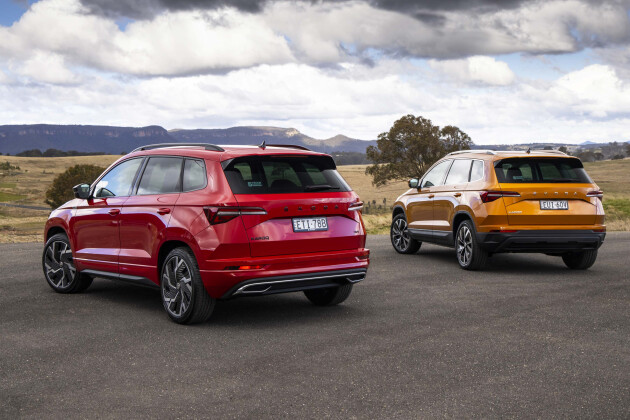 News
NewsSkoda announces permanent seven-year warranty
Lengthened warranty immediately available to new and recent Skoda customers
-
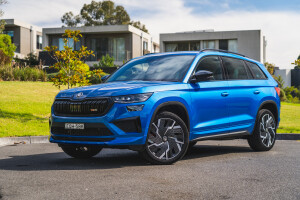 News
NewsSkoda's potential 15,000 sales thwarted by 2022 supply crisis
The Czech brand's performance has suffered heavily during the last two years
-
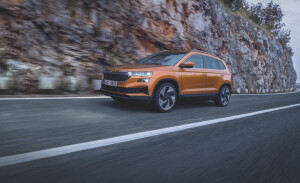 News
News2022 Skoda Karoq pricing and features for Australia
Skoda's refreshed medium SUV is on its way, due to arrive in the third quarter
-
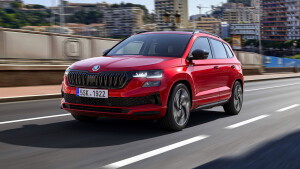 News
News2022 Skoda Karoq update revealed, delayed to third quarter
Skoda has given the Karoq a facelift, with added tech throughout
-

2022 Skoda Karoq: Facelifted SUV teased in new video
-
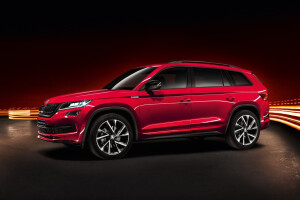
Skoda updates Kodiaq and Karoq
-
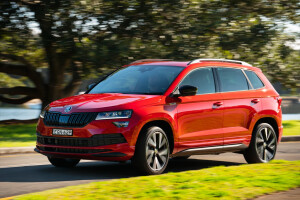
Skoda reforges Karoq SUV range
-

Five goofy-cool cars that might totally be you



